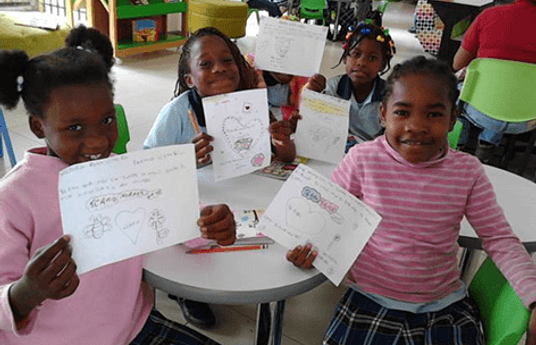What if, from an early age, there was a way to instill a different type of goal-setting and mentorship that had the potential to change the way kids interacted with their schoolwork and dreams for the future?
A “Dream Team” is a key component of Achievement First Greenfield, one of Transcend’s earliest partners. In short, Dream Teams are a community of champions who rally around every child to help them reach their greatest potential.
Here’s what the Dream Team looks like in the lives of two of our sons, Oswin (10) and Linus (6).
Oswin and Linus each asked six people to be members of their Dream Team (including parents, a sibling, and close family friends). Taking on the onus to lead, Oswin and Linus then asked the people on their Dream Team to come to a meeting at the beginning of their school year to share their strengths, goals, and dreams for the future.
Oswin shared that he wanted to be a YouTuber or coder for Apple. He also shared that he wanted to become better at math and writing essays, and to be more responsible.
Linus, our six-year-old, shared that he wanted to be a park ranger or a spy. (His mother and I are trying not to discourage his aspiring career in espionage.) He also talked about becoming better at writing and reading.
While they shared these things, they were offered encouragement, perspective, and support to pursue their goals. Each month they’ve checked in with each member through a video update. At the end of the school year, they will hold a meeting to share updates on how the year went, what they learned, and where they hope to go. It has been an amazing experience to see my own sons change as they were encouraged and surrounded by intentional communities that challenged them to become better every day.
The benefits that come from these communities are two-tiered. The first-tier benefits look like:
Trusting relationships. From a young age, kids begin to develop a series of trusting relationships with caring adults and peers. These are examples of healthy relationships we want our children to have and to look for as they get older.
Agency. Throughout this program, a kid has the ability to direct her own life. This gives her the responsibility to plan and dream what they want for the future while feeling empowered and equipped to make her goals actually happen.
Progress in goals. The students will make progress in their goals, as they have a team of people holding them accountable.
A second tier of benefits are harder to measure, but parents and teachers have already seen increased growth in many of these areas:
Grit. Students with team of people encouraging them to become the best they can be develop courage and grit early on. They know they have the support around them and that it’s safe to try new things, to fail, and to admit when they need help.
Long-term thinking and goal-setting skills. By challenging kids to think about what they want to accomplish and how to make that happen, they are training to think about their future selves. These kids are at the center of making their own goals and monitoring their own progress.
Increased confidence. In these Dream Teams, students are challenged to talk about themselves, their strengths, and what they believe their futures could look like. They set and accomplish goals throughout the year, showing themselves that they are capable of achieving more than they imagined.
Reflection/self-awareness. As students start each school year with an idea of what they want to accomplish and change by the end of the year, they are able to evaluate, self-reflect, and look back each month and year. This sort of exercise creates kids who are willing to examine their successes and failures to improve themselves.
Family and community engagement. While families are often members of the Dream Team, it’s an important aspect that other community members are involved as well (family friends, pastors, coaches, etc.). The engagement that this creates between the child and Dream Team is different in each relationship.
How do you implement this?
In a school, the Dream Team requires communication and teamwork from almost every piece of the school system (parents, teachers, budget, logistics, curriculum, assessment, vision, etc.) That’s why it’s such a meaningful, embedded process. As a parent, you also can integrate the Dream Team into different parts of your family life and embed this system into your family’s core values.
The greatest overall benefit to the Dream Team is what the students look like holistically throughout the journey of the education. By surrounding themselves with encouraging, important people, these kids develop life skills and habits that follow them into their adult lives. The Dream Team develops students into strong adults that will positively influence their communities in the future.



